Don't wanna be here? Send us removal request.
Text
Opening Statement
The following posts show my process for reflecting and evaluating my ideas while designing for the project Vandal with Care (later renamed creastreet), a street-centred design for the smart city exploring how this space and the idea of play can help illustrate individual and collective narratives in communities. Initially, this was to be used as a space to reflect upon the observations made while exploring the streets of London.
However due to shifts in thinking caused by feedback given in the crit and the sudden Co-Vid outbreak, I could no longer conduct such observations and my ideas shifted towards the context the streets are set in and the nature of our designs content. The posts are organised chronologically to show how my ideas evolved within specific spaces, but to demonstrate the shifts in thinking while undertaking the project. Thus each blog’s title has a date within it to illustrate when each post was created.
Each post is meant to illustrate a particular line of thinking from observations and other forms of inspiration, but some posts are used to explore problems spaces or scenarios with no clear solution. Furthermore there are posts presents to show how these ideas were applied in mockups with only light annotation.
The blog should be taken in by chronological order the themes of each posts are included in tags such as.
Observing the physical street: Posts 1-5
Harnessing the power of play: Posts 2,7,8
Layered Story Telling: Posts 3 and 4
Exploring the Street’s Context: Posts 5-10
What Is Harmful Art: Posts 9-10
Tags with Mockups
Naturalistic properties of the Street
Current Events and our Design
0 notes
Text
How the Streets can compare with Nature: Feburary 14th 2020
For our group project, we decided to scope our project around things involving the street. I tried to take pictures as a way to collect some visual research for ideation the next day. However it wasn't until I was looking though the photos that I noticed that streets have a lot of interesting parallels with rivers. They both have a sense of curvature that lead me into think of streets as urban nature.
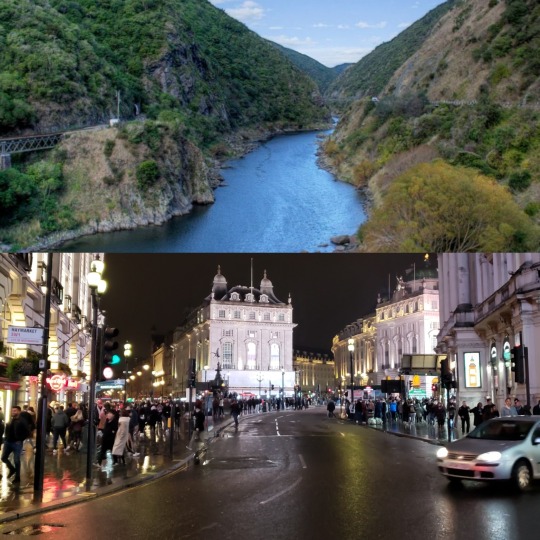
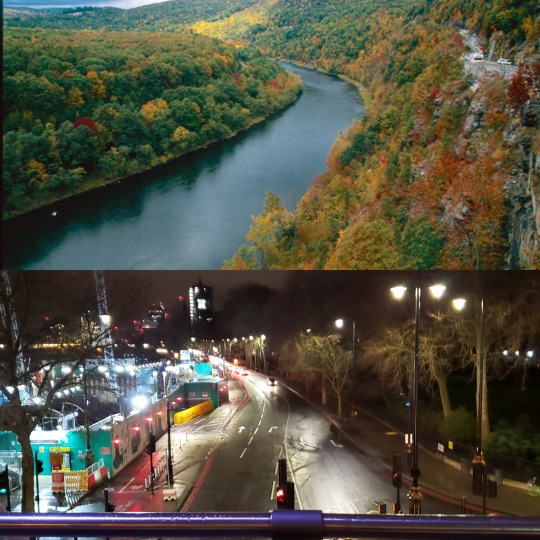
Through this I could understand what Belvis meant when stating that enriching design meant taking skills like photography to get specific perspectives and details but having them come into contact with the immeasurable. The immeasurable in this case being juxtaposition between streets and rivers as naturalistic parallels. The aim of creating such a juxtaposition was to create a different kind of meaning of the street that ordinarily would not be revealed through traditional research. I suppose this goes back an argument of visual research that it can reveal a deeper layer of what is considered ordinary. That being that despite urban streets being almost wholly removed from natural world due to being man-made, there do seem to be a hidden parallel when comparing the two together.
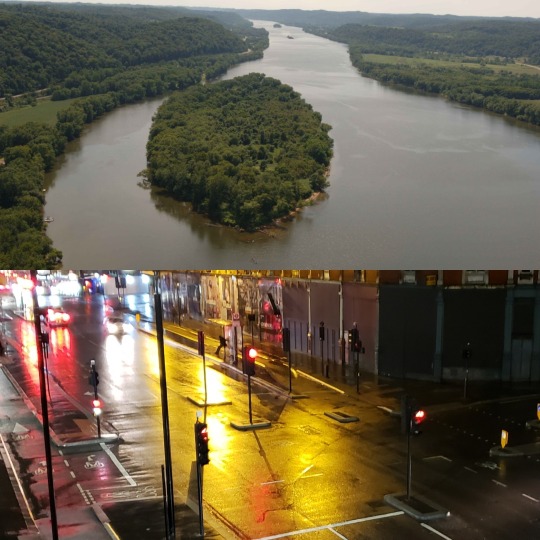
By making these images, I noticed that you could capitalize on this parallel by bringing forth other nature-based properties of the streets. One interesting property was found in the first picture of this set where just like rivers, there seem to be these small islands in between the streets meant for crossing that was again, taken for granted. These “street islands” typically had empty space that could be ripe for designing something, and what culminated from that insight along with the other images posted was considering how we could make streets more natural despite being in an urban space.
The idea was proposed to the group involved using guerilla gardening in these street islands as a way to achieve that, but it didn't seem to resonate with the group as much as I thought. However, it did lead to similar conversations of how we can capitalize on designing something around all the free space available on a street.
Thus in some ways, although the insights drawn from doing this visual research was not used in the end, I consider it valuable due to how it sparked different avenues of conversation and creativity amongst my group. Furthermore, I still think it could be useful as an archival report in case we need to we need to consider sources for future ideation.
0 notes
Text
Weaving histories and how play can be embedded in maps: February, 20th 2020
After the last meeting, we decided to take our focus off of the space within the street, and focus on how we can enhance the meaning of the street.
So to get inspiration on how approach this area, our group decided to go to the Play Well exhibit in the Welcome Collection.What I found was the very act of play itself allows for so many possibilities. I learned that it can allow for insightful looks into cultural influences and societal shifts (as seen through the changes with children's toys and games over time) that would otherwise be unknown.
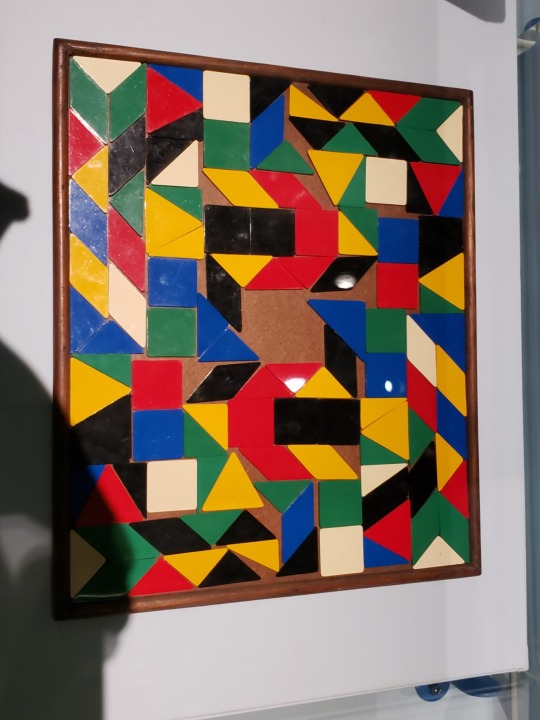
One of things that stuck out for me was the mosaic on display and how I learned that mosaics were used by children to express different stories through play. This was particularly interesting to me as upon rearranging the pieces could lead to different pictures, and lead to varying interpretations and stories. All of which created in a lighthearted, playful context.

(Image source: https://booth.lse.ac.uk/learn-more/what-were-the-poverty-maps)
This lead me to think about a map I saw at a separate museum earlier this year created by Charles Booth, which visualised 19th century London based on class in one of the first examples of social cartography. After going through the original study, I found that the survey captured much more than income and had data concerning working conditions, migration, leisure.
I began to question why these aspects couldn't be made into maps as easily, and it occurred to me that these aspects were just like a mosaic. Each aspect of the survey was its own piece that lends itself to a tapestry of a neighbourhood or community which could thereby be subject to interpretation. In other words, what if there was a way to visualise all these different pieces into a cohesive whole that tells a story.
It was from looking into these different mediums of expression, that I managed to find commonalities within their design. That being both the mosaic and Charles Booth map study both used pieces (ie: different shapes in a mosaic, and the circumstances of various neighbourhoods in London) to tell broad stories. Furthermore aspects of both mediums separately lend themselves to one another. For example, the use of pieces as an alternative method of playful illustration as seen in the mosaic could be complement a map.
Furthermore, the use of pieces to simultaneously tell individualised stories as seen with each house in a neighbourhood, but also contribute to a broader narrative seen with collection of houses indicating a block, neighbourhood, or districts level of income. This could lend itself to mosaics providing each pieces could be contextualise to convey a narrative.
From these aspects I was able to construct alliances based on their definition from the book Critical Fabulations. Specifically two seemingly different objects were analysed to find relationships which could thereby inform a design. In this case, the use of mosaics as playful story telling and narratives weaved by Charles Booth’s study could complement each other when given the right design space.
This conclusion led me to imagine a world where map making could be playful, and the results of that play could result in a rich tapestry that tells a community’s story. Each community could piece together their map using a playful format like art and make it about various aspects like leisure, celebrations, conditions similar to how mosaics are created with different shapes, colours, and sizes. This map could then be contextualised as apart of a grander mosaic of other communities which could tell stories of town, cities, and even countries. Thus, by making these alliances between two separate entities, I found a way to enhance the street by giving it context via compositing narratives through play, potentially giving the street a layer of interpretation.
0 notes
Text
Personal narratives and the exploration of layered story telling, Feburary 29th 2020
When I was growing up, I lived right next to the high school I attended, and I could always stare at this rock from my house. Every couple of months or so the rock would be repainted for various events like class reunions, graduations, and even asking people to senior prom.
I never really knew when the rock was first painted but I imagine this tradition has been going on for a long time, so I would always ask myself how many layers were on that rock. It became a pervasive thought growing up where I could imagine taking a fire hose, and washing the rock just to see how many layers were on there.
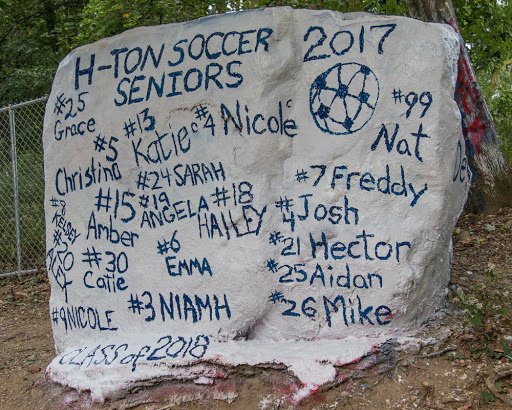
(Image source: http://www.hufsd.edu/articles/2017/october/18d.html)
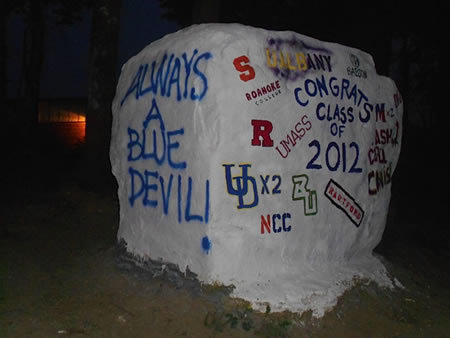
(Image source: http://www.hufsd.edu/news/stories/2012/june/25d.html )

(Image source: https://tbrnewsmedia.com/class-of-1966-to-award-scholarship-in-honor-of-reunion/ )
When I was growing up, I lived right next to the high school I attended, and I could always stare at this rock from my house. Every couple of months or so the rock would be repainted for various events like class reunions, graduations, and even asking people to senior prom.
I never really knew when the rock was first painted but I imagine this tradition has been going on for a long time, so I would always ask myself how many layers were on that rock. It became a pervasive thought growing up where I could imagine taking a fire hose, and washing the rock just to see how many layers were on there.
I suppose this was because I was curious on how many stories were told on the rock and how long the tradition has been going on for. More importantly, the different murals of the rock could unveil a grander story being told by a community. Maybe to someone who isn't familiar with American culture, it could be a valuable artefact to learn about the the American High school experience.
In some ways, although this wasn't exactly created for the purpose of design, the rock could be considered a cultural probe. Specifically it could be easy to imagine a design team taking that rock or any surface and let the community tell stories. It could be used to compare not only American high school experiences, but to understand differences between what American teenagers consider important to teenagers in India or the Democratic Republic of Congo. We could then use to gain insight into their daily lives without appearing like we’re trying to solve a problem that isn't there and potentially design accordingly similar to how Bill Gavar and colleagues used probes to inform their own designs.
Just as important is using layered story telling to understand how each layer was the result of fabulations. Meaning that a way to look at each layer is to understand the history and context behind it. Not just looking back at prior layers, but understanding details like current events during the layer’s creation, aesthetic preferences popular at the time, and even something as minute as how some sports teams in the school were doing.
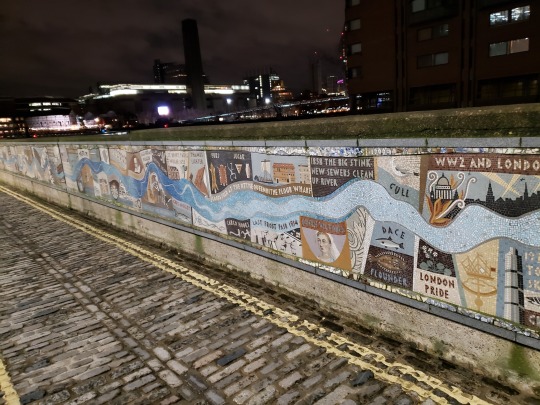
The rock’s use of layers could then be used as a creative (if not impractical) way to express the passage of time and collective narratives. I found this to be important after looking at mosaic mural by the River Thames. The mural itself uses many of the same principles I discussed in the previous post, where it displays London’s history in this patchwork style that could be looked at individually or as a whole. However, taking photos of the mural revealed a key flaw that I didn't exactly take into account.
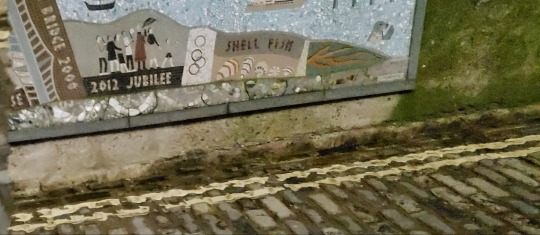
Specifically, I envision the mural as something to be iterated on. However, once the mural reached the end point as shown here, there was a finite space to keep building off of. Meaning that this mural will at some point come to an end. However, if one were to instead use layered story telling similar to the rock, then there is no designated end, one can simply add another layer to the mural, which could signify either a continuation to the former layer, or tell something entirely new.
After coming to these conclusions I can empathise with some of the struggles the author of Critical Fabulations had designing Spyn. Specifically she tried to be objective throughout her process and not let her own assumptions taint it. She also tried to cast out data that may not considered as valid to UCD, relying on interviews and observations made impartially.
I had similar struggles as we’re taught early on in HCI to not rely on any personal experiences and to listen to users based on specific methodologies. I really began to question myself prior to writing this post if the use of personal experiences were valid within design. I questioned whether proposing the idea using this personal context would come off as egocentric, or if it would even make sense because it was so personal.
However, I realised not using all that is given to you including personal narratives and experiences would be trying to piece together a puzzle with missing pieces. It would be difficult for me to say whether I could come to the same conclusions by looking at layered artwork that I didn't have a connection too. I could maybe understand the mechanics and the context, but I don't think I would of been as motivated to dig deeper into its importance as a cultural probe as I would of for the rock.
Similarly, I was about to delete the final picture of the corner as I initially perceived to be a mistaken shot within no real value. However I realised it was perfect for illustrating to my group how finite space can be for any given artwork on a single layer as an idea. It was through using unconventional artefacts that a potentially meaningful contribution to our group’s design was created. Thus, I aim to include more unconventional photos, videos, or experiences in my design thinking in future blog posts.
0 notes
Text
The devils in the details: A reflection on the previous post. February 25th 2020
After discussing my ideas on layered story telling to my group, one member shared an article that made me rethink my approach to layered story telling. Specifically, my initial thinking made me envision the concept as needing overt changes to formulate a narrative, that parts of a narrative could not be created unless a completely new piece was created. Now looking at that post I can understand how I failed to broaden my inquiry. The examples I talked about were more sizeable in nature like murals done walls and rocks. I didnt take into account how smaller works demonstrate the same idea using more subtle changes.
The article that lead to this critical reflection talks about the project Paintings Uncovered which aim to chronicle an artists processes by revealing hidden layers in a given work using Reflectography. The article made me think of how granular these layered narratives can be, and that a single layer’s process could contribute to a broader narrative, as thus far I only looked at changes on the broader level as meaningful narrative.
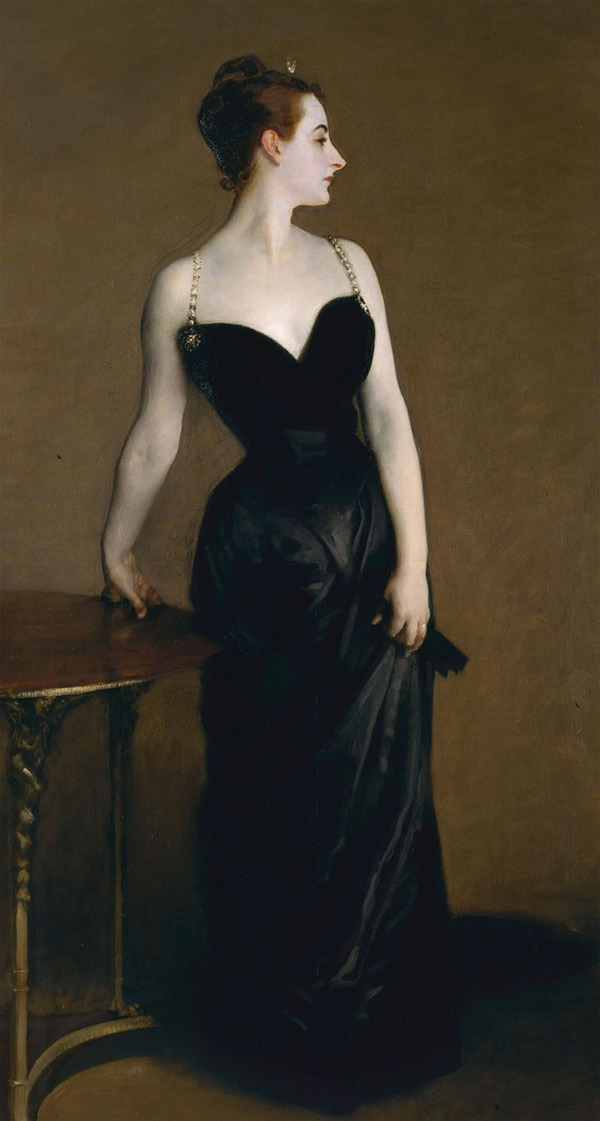
(Image Source: https://www.metmuseum.org/blogs/digital-underground/2015/paintings-uncovered)
A excellent illustration of this idea from the article concerns the painting Madame X, by John Singer Sargent showing a woman in a black dress. From the work of paintings uncovered, a prior version revealed an intriguing narrative based on a small edit made in the painting.
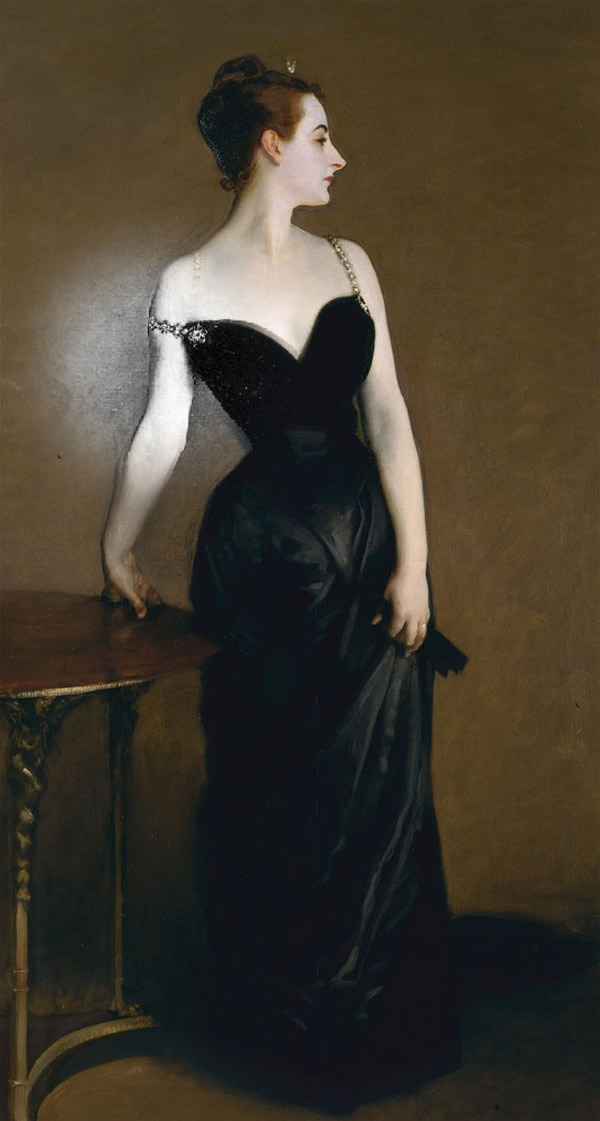
(Image Source: https://www.metmuseum.org/blogs/digital-underground/2015/paintings-uncovered)
As seen in this photo the prior version had one of the dress’s straps going off of her shoulder. This was the subject of controversy when it was unveiled in 1884, as the straps position implies a seductive nature and by extension promiscuity. This caused the artist to repaint the strap such that it was properly on her shoulder in 1916, and was then later sold.
Based on an (in today’s standards) inconsequential detail, this prior version of a painting, ended up unveiling a lot of narrative about the not only the painting but also what the painter went through when creating this. This could therefore make it possible that narrative can be made from of a singular painting within a collection, but also that a single layer could uncover hidden histories and narratives based on minute of changes within it.
However unlike broader changes like a single painting in a collection, where its place in the narrative is more concrete, these subtler changes may not be as rich in history and could be generated based on interpretation.
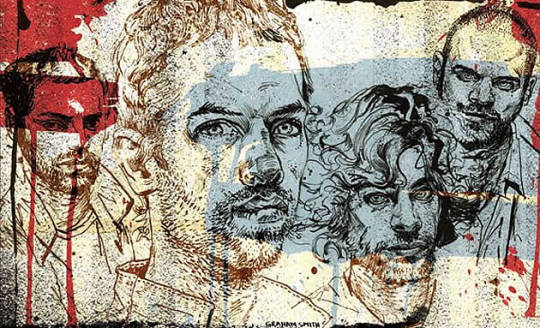
(Image Source: https://steemit.com/painting/@mmohsinraza/how-to-make-art-project-creative-use-of-media-for-painting-part-02)
Take for example this mural of four men, while the three men on the right have seemingly regular looking faces, the one furtherest to the left seems to have a red stripe painting over his face. This could generate potential meanings and narratives, like maybe this person was not as well liked as the other three. Another way to look at it is that maybe the stripe was not there initially and that person could of done something of note to garner the red stripe. It might be sinister, or it could be interpreted differently based on the context of the painting as well.
Overall, there could be a near infinite amount of meanings that could be taken away from this small detail, which demonstrates how integral iterative processes and subtler elements are in a given work when discussing layered story telling. By potentially leaving the meaning of these changes to interpretation it encourages critical thinking within the viewer. This could then make them think not only about how minute changes connect to an overarching narrative, but because they are actively making their own meaning of such changes and works, that they might understand how such narratives can relate to them, and enriching one’s own narrative.
Thus, by looking at these articles and work, not only was I able to view narrative from a more nuanced perspective enriching the design of our concept. Additionally this nuanced perspective could help users connect and empathise with given works than was thought possible, and help deeply embed themselves in the narratives generated by our concept. Although I’m unsure how much detail concerning granularity can go in our design without being overwhelming, I believe the ideas generated here will further influence my thinking in later additions to this workbook. Specifically in that we should not discount even the most minute of details within art and design as they could hold big implications.
0 notes
Text
Harnessing the naturalistic properties of the street, March 8th 2020
After a feedback session on our group idea, one of the points that really stood out to me was how we could avoid using technology to make streets more playful.
Initially it did not occur to me to think outside of the digital realm for our idea, because of the association between smart cities and technology. However from the observations I conducted, I could imagine a world where streets were less reliant on technology. Specifically, I noticed that streets had hidden qualities to them that people ignore. However unlike the first post where I believed that people ignored the parallels between streets and nature, people were also unable to see how the streets can be enhanced by their environment.

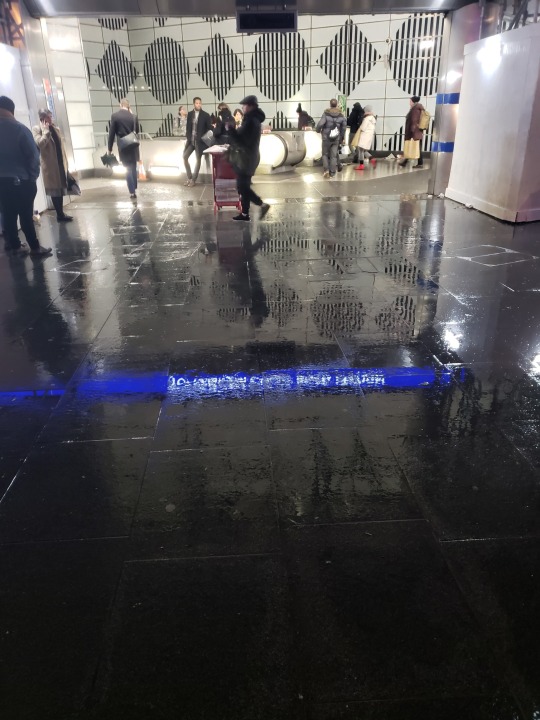
Take for example this picture, the first was taken inside of a tube station, the floors of the station often look just like this with no colour to them because of the good lighting.
However taking a look at the sidewalk just outside of the station, because their are no artificial qualities like good lighting, theres a lot more on display. Specifically the lighting from the station is projected into the sidewalk, and because it was raining around the time it was taken, the image on the sidewalk almost looked like a parallel world.
Furthermore it wasn't just lighting that affected how the sidewalks looked but also the amount of rain that fell on the street.
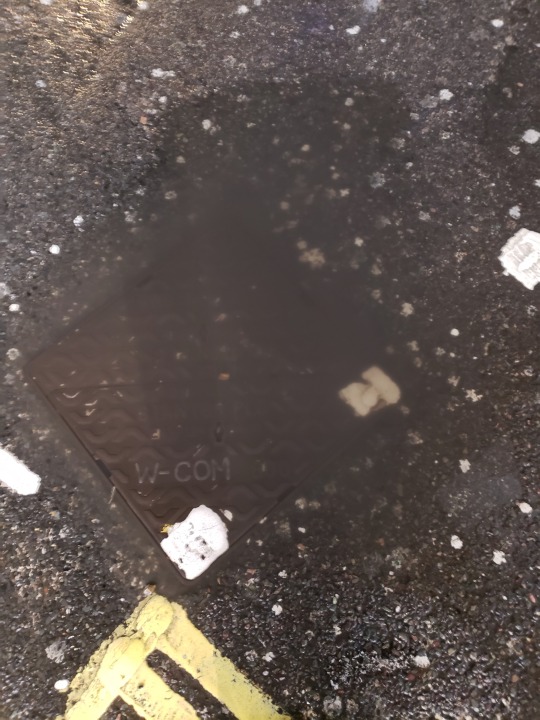
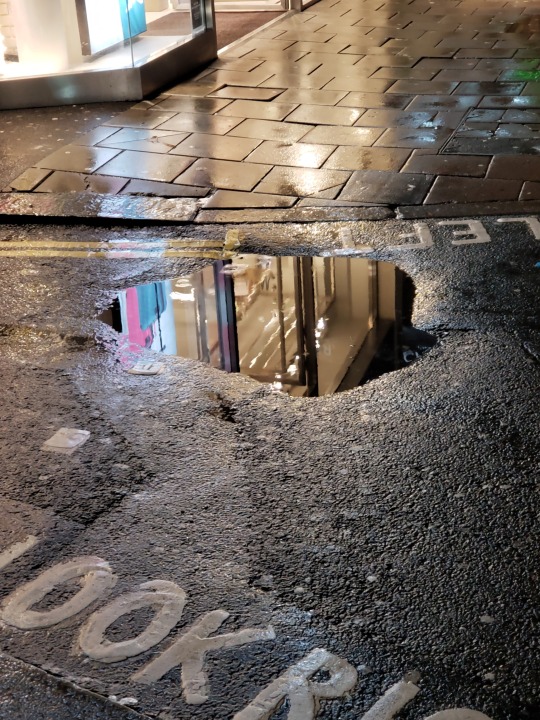
If you take a look at this next picture of a puddle on the street, you could see a more clear reflection of the store close to it rather than a blurry one like in the station. Even looking at the same puddle from a different angle revealed the uniqueness of the view. Specifically the next picture shows the same puddle taken from a top down view instead of at an angle. It was from this that I noticed that based on your location, the design of these rainy streets could change.
vimeo
However the most interesting observation I made was seeing how interacting with that puddle could enhance the street. This was something I managed to capture on video as an article for this module talks about how video gave a more richer view of people’s everyday lives and help designers speculate more concretely. I could see such insights happen in person as despite being able to see the following scenes in person, being able to watch that moment several times via video helped me capture more subtle aspects that I may not have seen otherwise.
In the first video, while most people avoided the puddle, one person dragged their bag through the puddle. That small interaction ended up changing the image displayed through the puddle by creating waves that distorted the image and creating a new temporary element on the street.
Just as important is the second video, as we can see a taxi run through the puddle. As seen with the bag in the former video, the taxi’s interaction with the puddle changed the puddle’s image, but the wheels also spread some of the lighting and colours from the store onto other parts of the street making it more decorated than prior to the interaction.
It was from these small observations captured through photos and videos, that I realised that I was being too constrained in my thinking. By being able capture different juxtapositions through photos and capturing subtle interactions of different aspects of a street, I realised that I was observing and thinking about the streets as a fixed constant. That unless there was some form of human or technological intervention, streets will remain unchanged.
However what I failed to realised is that nature, motion, and angle change how streets are illustrated. Rain can reflect light onto sidewalks, and that display of light can change depending on where you are in the street. In other words, instead of using a fixed notion of what a street is, we should be looking into is the properties that complement the street, how it changes the street, and how we can use those properties to make the street more playful.
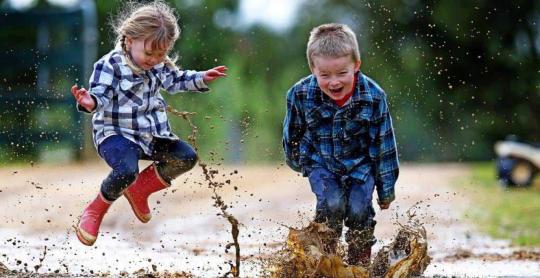
(Image source: https://www.scoonews.com/news/let-your-curious-child-jump-into-that-puddle-here-s-why-8834)
Finally, the conclusions I made helped me recall childhood narratives that could be fabulated upon. For example, as a kid I used to jump in the puddles with friends whenever it was raining. While the memory was subjectively playful, I realised that those same actions are still using different aspects of what i’ve discovered.
Furthermore, if playful moments like these could be capitalised in our design, not only would this be playful for kids, but also for adults is it could be a mechanism for different things in our design. Splashing in a puddle could help unveil a new layer to art on the street, or maybe provide a distortion effect similar to the contents of the videos. The possibilities are endless and I hope to explore this more with my group in the coming days.
0 notes
Photo

This mockup was used to demonstrate how we could take advantage of the naturalistic properties of the street from previous blog posts. I aimed to show how the perspective and environment (rain) could help enhance our design by showing previous layers on the street. Furthermore I aimed to demonstrate how using these aspects could make our street more naturalistically grounded, feeling more apart of the physical world rather than purely digital.
While the grouped seemed to like the idea, I believe the ideas I tried to illustrate here could only illustrate so much. I wanted to show other aspects of what I found in the prior blog like how the use of motion could enhance our design’s interactivity. However demonstrating such things would unfortunately require more technical skills than I have. Thus while I wanted to illustrate so much more for my design, I believed this mockup would be sufficient for illustrating my ideas and giving my group a way to explore this design space.
0 notes
Photo



I created this image in further illustrate my ideas about how layered story telling could be implemented for a more streamlined narrative. The images were meant to demonstrate a time dial effect in which pedestrians could opt to view a reflection of the street as it appeared in the past. Furthermore, I tried to use a portal effect similar to what I saw when the rain was on the streets.While my group did understand the concept I was going for with layered story telling when discussing the rock from my childhood, the images appeared to be counter productive in that no one in the group was really motivated from these images.
They cited that the idea would require external content from outside parties in communities and might conflict with our design’s accessibility. Furthermore, from this critique I realised another underlying problem in that this concept lacks context. Although the imagery was meant to be interpreted by onlookers for them to make connections to their own narratives and past one’s. I became concerned that it may not be as meaningful as user generated content, and could be hard to empathise with a shot of the city in the past without much meaning.
However although the idea was abandoned, I decided to post the images for future reference to invite people to use these mockups to reflect upon their narratives as originally intended. The aim is to use this as a probe of sorts by inviting anyone to comment on how the imagery affected them and hopefully gain future insight for where I could take this idea in future projects.
0 notes
Text
How the context of the street can impact our design, March 30th 2020
Up until this point, I have been focusing on how the street can tell different kinds of stories and be playful. However the street does not exist in a vacuum, and any given neighbourhood has went through a myriad of different lifetimes depending on who has lived in it.

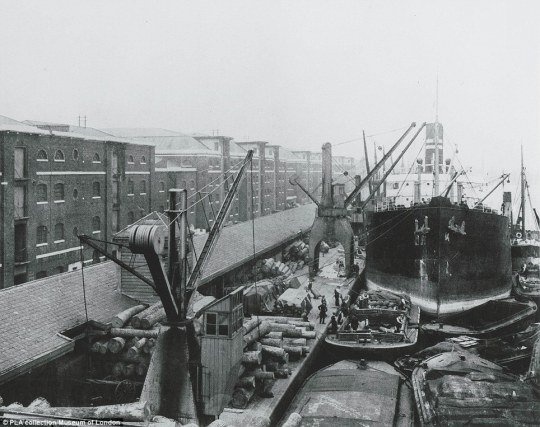
(Image Source: https://www.dailymail.co.uk/news/article-2325399/Canary-Wharf-How-busy-financial-centre-thriving-port-taking-sugar-rum-elephants.html)
Take for example these images, the top picture shows Canary Wharf in 1900 when it was still a thriving port. Up until the 1980s it was mainly a low-income community that although did have its share of struggle, had a rich history with vibrant communities that had a shared identity. Now as seen in the next picture the area has become the financial capital of London being home to endless skyscrapers housing various multinational corporations.
The change was not subtle as many families were kicked out of their homes and rapid redevelopment began in the 1990s turning what was once a centre for the working class into a gentrified cavalcade of high-income professionals, and high-rise buildings.
The area while touted as an economic lifesaver providing as many jobs as the former docks did, became a hollow environment as a piece of London’s greater whole.
I say this because the first time I went to Carnary Wharf, there was this sense of surrealism that pervaded my thoughts. It looked like no other part of London including the higher income areas. The area felt empty with no one around and didn't really have any traditional London architecture like the victorian brick houses seen in any given neighbourhood. It then occurred to me after talking with a friend, that the area felt more American than it did British with its skyscrapers and focus on modernisation.
My thoughts concerning this were not in a vacuum as articles are abound in the internet talking about the extreme displacement that exists in Canary Wharf with the area mainly houses foreign investors who don't really live in these high-rises.
However what was more important to me is these changes come with both an economic cost, and a cost of character. What I mean is that by changing the area in such an extreme, you loss fundamental piece of that community’s character. With each new office space and high rise built, a neighbourhood pub or local restaurant is lost resulting in a significant change or loss of narrative. Specifically, these areas can no longer generate stories like how the neighbourhood was where someone found there passion for art, music, or sports, or how the community street markets brought people together that ordinarily would never meet.
Thus, from learning about the context of Canary Wharf and the area surrounding, I realise there is a feeling of powerlessness pervading that community. Therefore I believe a key tenant to our design should be to make it more accessible to help residents take back control of their community’s narrative.



(Sources: https://www.inc.com/tess-townsend/uber-moving-into-oakland.html
https://www.theguardian.com/commentisfree/2018/aug/31/airbnb-sharing-economy-cities-barcelona-inequality-locals
https://thetempest.co/2017/05/01/now-beyond/tech-money/tech-industry-gentrification/)
While the story of Canary Wharf may be a poignant one, this cost of character and feelings of powerlessness is widespread. There are countless instances gentrification throughout major American cities, sparking tensions on whether the economic benefits of big business would affect longstanding diverse neighbourhoods.
When I first learned about such trends years ago, I was surprised that such changes even occurred. While I grew up in a suburb near New York, I remember going to the city multiple times growing up, but failed to notice any overt changes similar to canary wharf. This line of thinking encouraged me to reevaluate my approach as I had to internalise how these periods of change could be more subtle for non-stakeholders. I initially thought revealing a more insidious nature to this phenomenon.
More importantly, looking at these stories of ongoing struggle, I found another trend that could impact negatively impact our design without proper care. This being that unlike Canary Wharf where the development was mainly brought about by finance, gentrification appears to driven by expansion within the tech sector. The implications of which may bring garner reasonable contemplation on whether our design will be met with an embedded cynicism.
youtube
Such dystopian notions are best illustrated in current additions by tech companies as seen here. The video shows a security robot created to deter the homeless population in San Francisco. While the idea has garnered significant criticism, the highlight how in communities view. As it patrols the street it is met with disgust (shown by the one onlooker visible), and even horror to some with another pedestrian saying “thats not creepy at all”.
Looking at such reactions that invokes thoughts of “techno-cynicism” in that people may be cautious and unwelcoming towards tech based solutions due to their role in the stratification of power. That while many of these companies design for the smart city with utopian intentions, communities may be skeptical towards such promises due to their mixed reputation. The implications of which mean our design may be viewed as disingenuous or even misinterpreted as a mockery to the neighbourhood if presented in a specific light.
Furthermore through the exploration of gentrification, hidden histories arose from recuperations. Specifically understanding the how these trends weaved a narrative of technological dystopia embedded within changes to streets and communities. It therefore leads to an underlying tension exists within our design. That being while we want to let communities take control of their own narratives, we must do so in away that does not incur an impression of high-tech solutionism, as it could come off as disingenuous or dystopian.
While I cannot say I have any concrete solutions to the matter currently, I hope that these takeaways can help me explore more dystopian implications of our design and steps towards alleviating such notions.
0 notes
Text
How play can combat cynicism, April 2nd 2020
Going off of the previous blog post, I was trying to find potential avenues for figuring out how communities can capture its characteristics while keeping control of its own narrative without outside influence and how to design to discourage cynicism. I believe a vital piece to understanding possible solutions was how a YouTube video helped me explore how previous ideas about play and narrative could be expanded on.
youtube
The video above talks about the uncensored library, a project in Minecraft that aimed to create a repository of banned books and articles in oppressive regimes. The people who created this saw a loophole where people living under these regimes could still read banned articles and learn about the authors who went above and beyond to write them.
The important thing that came out of this for me was that people used a fairly novel way to take control of a specific narrative, bringing to light banned articles and books from oppressive regimes. Furthermore, the novelty of this project is that used playful methods to do it.
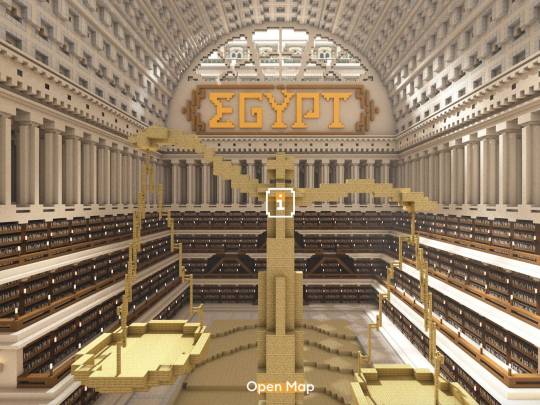
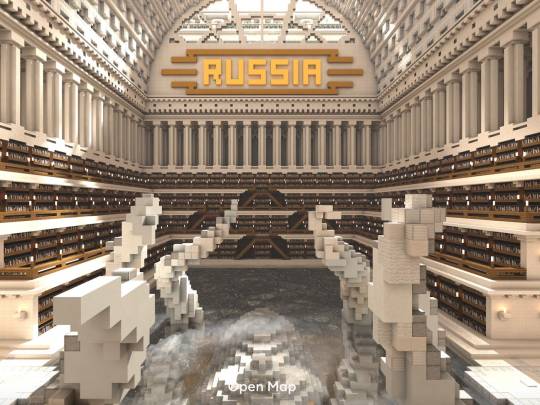
(Image source: https://www.businessinsider.com/minecraft-library-censored-newspaper-articles-online-books-rsf-reporters-borders-2020-3?r=US&IR=T)
Take for example the two pictures above this paragraph, the following are rooms within the uncensored library that use statues like the kraken and scale to symbolise how limited press freedom is.
Such symbols could invite inquiry on whether they could be replicated in a non playful context? Did the creators think of these symbols originally, but were not motivated until they found the perfect canvas. Perhaps they were inspired by play as a creative medium to explore how to best display such analogies. Through these speculations, everything came together as play can not only benefit a person’s mental well being but bring to light stories that otherwise cannot be told. That it’s possible that playful contexts could provide the creative medium needed to encourage vivid imagery within our design and encourage communities take control of their narrative. One context in particular I want to focus on is the idea of creation as play.

(Image source: https://seriousplaypro.com/2015/06/02/using-lego-serious-play-as-a-design-thinking-tool/)
The following is from a workshop involving serious play. These workshops typically involves groups building models using Legos to tell stories or express ideas. The idea is that when people have an infinite amount of possibilities for things to create as lego block are, then it will allow them to better express themselves creatively. This has been adopted by several organisations to encourage more creative thinking and illustrates including design and UX firms how play can be used encourage creative expression, generating richer narratives.
Furthermore based on other research, play may have other benefits outside this. There is considerable research showing that the act of play in any form can increase mental and emotional well-being. It was from this that I found a potential relationship between play and key design thinking and in turn a potential way to alleviate some of the concerns outlines in the previous post.
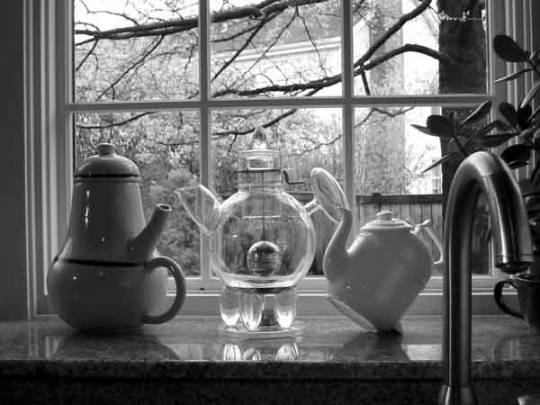
(Image Source: https://jnd.org/emotion_design_attractive_things_work_better/)
Take these three teapots for example, Don Norman discusses them in the context of which one he uses. He says he uses none of them normally as they are all impractical in different ways, but he still likes to display them and use them when they match his mood as it makes the tea taste better when it does. The analogy Norman proposes helps illustrate his broader point that designing for positive affect can help increases tolerance to flaws within a design. Thus through Norman it is possible that encouraging positive affect through play could help minimise the cynicism or cautiousness brought on by tech-based solutions in neighbourhoods at risk of gentrification.
Furthermore, Norman also points out how positive affect can encourage creative problem solving. This further reinforces the notion that the people who created those models in Minecraft used the playful context they were in as both the tool and canvass to envision creative ways to symbolise a potentially complex topic.
Thus by using speculative thinking to empathise with creators, I was able to weave several alliances (as described in critical fabulations) between our design space and play. Furthermore through the use of recuperations I was able to take material previously read in prior modules mainly for design a way to ground my ideas. It is through these methods that I understand the importance of being able to take previous ideas and apply them into different contexts within our design space. I hope to not only encourage an additional look into play based on the ideas discussed here, but also attempt to see where prior ideas could help create solutions for any other dystopian implications our design may have.
0 notes
Text
Social distancing in our design and playful interactivity April 8th, 2020
Although my group believed we had a solid project idea, there were a couple of curve balls that were thrown at us due to the ongoing Coronavirus pandemic. Specifically since most if not all of London was on quarantine, not many people would be going outside. While most of these outbreaks are temporary and life goes back to normal it did provide an interesting challenge to overcome when designing interaction for our technology. That being how do we encourage people to make street art when there is no street or outside surface to place the art on.
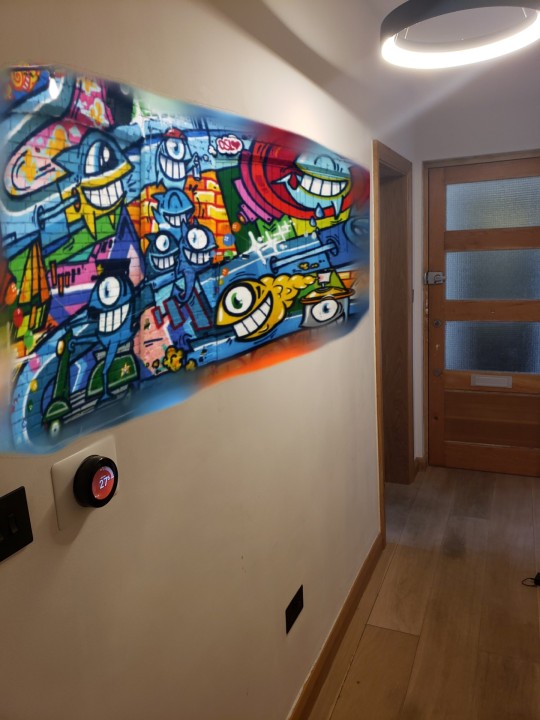
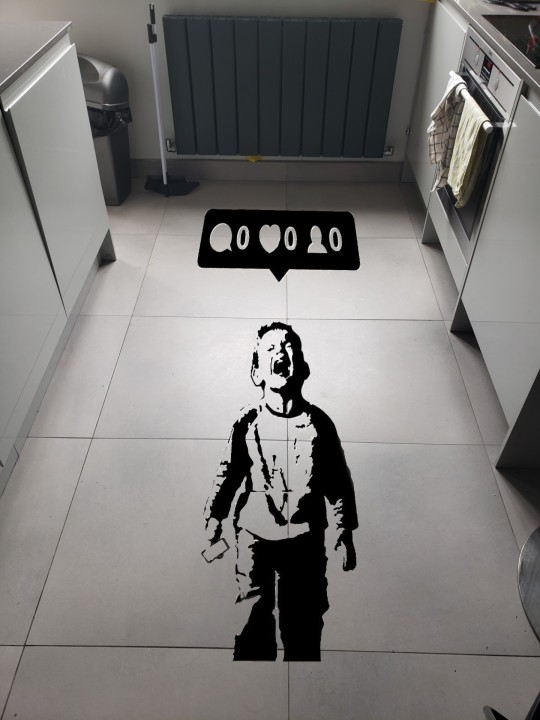
Although my group believed we had a solid project idea, there were a couple of curve balls that were thrown at us due to the ongoing Coronavirus pandemic. Specifically since most if not all of London was on quarantine, not many people would be going outside. While most of these outbreaks are temporary and life goes back to normal it did provide an interesting challenge to overcome when designing interaction for our technology. That being how do we encourage people to make street art when there is no street or outside surface to place the art on.
Even without the co-vid crisis, I believe interaction without the street would still need to be considered since there are still a various people who would benefit from increasing creastreet’s accessibility. These include the elderly and disabled persons who may be unable to contribute if they constantly need to go outside. In this case it is important, especially when capturing the narrative of a community that all its members can contribute equally or else we are still forgetting important stories that could bring more clarity into life within the community.
We came up with several ideas that made it into the final concept like using a smart TV application to designate where art could be posted, along with scanning notebooks on a surface to transfer it onto the street. However one of the things that was considered that I found interesting is what if the street art could be made inside the house.
In order to flesh out this idea, I created a few mockups via photoshop to demonstrate the idea. Using these images as mockups helped me discern how images can help invoke sensory experiences, but also that such images can be mutable. In this case, I decided to use these take both principles to see whether I could a novel visual experience from modifying the photos. The results of which I believed looked realistic enough lead to an interesting line of thinking.
Specifically, the photos were in my flat in areas usually considered off bounds for drawing like the walls and floors, and I wondered why we no longer let ourselves draw on these surfaces. The main reason obviously is theres a lot of tedium in having to clean it off, but what if there was a way to do where that tedium is taken away.
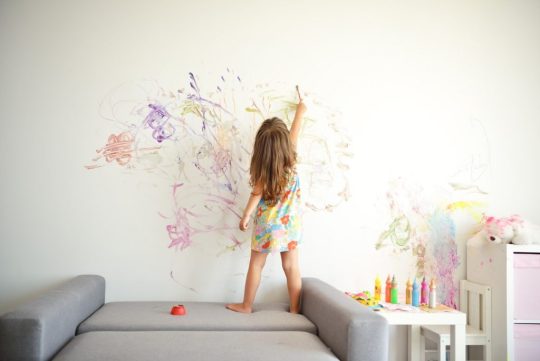
(Image source: https://www.apartmenttherapy.com/these-parents-had-a-hilarious-reaction-to-their-kid-drawing-on-the-wall-252896)
I say this because as kids we’re always experimenting with different kinds of expression that may not make much sense to adults. While the main one that comes to mind in this context is drawing doodles on the walls, kids often try to express outside of typical boundaries like colouring outside the lines or making music with a bunch of sticks.
A personal example of mine was when I used to play with action figures I wouldn't stick to playing with just the star wars or toy story toys but I would use all of them to come up with all kinds of scenarios like buzz and woody saving the day and fighting Darth Vader. Its these kinds of chaotic instances where when unconstrained by norms, kids can make up unique and playful scenarios.However as with growing up we’re taught to color in the lines, that music can only be played on instrument, and that Woody and Buzz will never meet Darth Vader because their not real and in different franchises.
In fact when we learn more about the world, we often become constrained by our own knowledge. Specifically, we know we cant colour on the walls, because that will just make the house messy and will take forever to clean up. I believe in this thinking greatly limits our capacity for play and thereby limit the expression of narrative.
Thus, by creating these mockups I was able to not only envision a rough idea to address the challenge creating art in a quarantined world, but how it unlocks a forgotten expressive force. How by un-constraining users and enabling them to draw wherever they want in the home like the walls the floors, even the toilet, we can invoke a stronger sense of expression by invoking methods we used as kids, but stray away from as adults. Hopefully by allowing ourselves to think as children, without rules, or boundaries, but all the imagination in the world, we can see more expressive narratives than if we just let users draw on their smartphones or tv’s
The only shortcoming of this exploration is while images can go so far in exploring the (possible) ordinary context of creastreet, images are still static. One thing I could perhaps do in the future is to create other artefacts like a short video to illustrate the interactivity of the proposal in the context of ordinary usage to deepen my exploration.
#post#Exploring the street's context#Harnessing the power of play#Current Events and our design#post 8
0 notes
Photo

This image was created to explore how creastreet could convey narratives in the form of current events. I found using images and messages created during the Coronavirus epidemic was the most relevant way to do so, as one could look at such imagery as a way to generate a world where our technology currently exists. Similar to how I created the mockup of how we can use naturalistic properties of the street, I wanted to use these exploratory pieces to see how our design could be less speculative and more grounded in our ordinary lives.
In particular how would our design be used in the during the current crisis, not just in terms of interactivity, but a potential tool for the public good. I imagined a world where creastreet could be used to display public safety messages like the one shown here to ensure people are informed about precautions they could take to ensure we “flatten the curve”. While such speculation was antithetical to our goals of promoting creastreet’s accessibility and focus on user generated content, I believed these images were useful in getting my mind to think about our design in the present, and get in the mind set to contemplate our design’s interactivity in the current crisis.
0 notes
Text
Harmful Art and the Use of AI April 8th, 2020
When discussing what concepts might appear on the street in our design, we can only really speculate upon what might arise. Thus far, our group has discussed in length about what kind of environments might generate meaningful content, along with the kinds of topics and situations they might create narratives out of. However we have not tackled instances where things could go wrong in terms of how people could generate content.
Specifically, my group thought of a poignant question of whether people could be trusted with drawing non-harmful content on the street. Extra consideration was taken in this case as while we wanted to make our design to be as accessible as possible, we do not want to introduce another outlet for bad actors to post harmful content.
The hypothetical solution we came up was an AI responsible for oversight, it would immediately erase harmful content if detected. Looking into this, we found interesting pieces of inspiration as to how this AI could potentially function.

(Image source: http://deepangel.media.mit.edu/)
The following GIF is from Deepangel, an MIT project that aims to explore the aesthetics of absences within pictures by using AI to erase specific content. Their outputs allowed us to envision how the the AI could interact with the street art by showing the process of how erasure by AI could be undertaken. What really stuck out to me is how vivid the imagery is in the erasure process. The picture shows a much slower process of deletion, it shows the content being slowly taken apart as if its being absorbed into the surface rather than instantaneously wiped away.
In a previous post, I discussed how naturalistic properties of the street can be used to enhance our design’s aesthetic. I think this GIF demonstrates some of the ideas mentioned by using properties like colour and motion to make something entirely digital look more naturalistically grounded and giving a “feel and texture” often seen in photo diaries and provides an illusion of being apart of the physical world.
I thought based on this, there was an argument that this method of erasure could weave itself into the design seamlessly. However I decided to further consider the proposal’s implications by using the principles of a reductio ad absurdum thought experiment to speculate on them. Specifically this involved taking a claim and envisioning outcomes by taking it to an extreme.
The claim being another proposal from our group involving AI analysing cultural data to gather guidelines on harmful content. This was considered useful it could let the AI self-update ensuring the standards for what is or isn't harmful art is current with the times. Where this becomes dystopian is the notion that AI are capable of learning what is given to them, but usually without a moral compass.


(Image source: https://www.independent.co.uk/life-style/gadgets-and-tech/news/ai-artificial-intelligence-dangerous-text-gpt2-elon-musk-a9192121.html
https://www.vice.com/en_us/article/kb7zdw/microsoft-suspends-ai-chatbot-after-it-veers-into-white-supremacy-tay-and-you)
here have been numerous accounts of AI’s capability to spread harm based on how it processes data. The articles mentioned above talk about how AI with good intentions could be distorted based on internet content. The first of which discusses how an AI model could string text together to spread harmful messages from hate groups. The other discusses how an AI used machine learn to enhance its conversational understanding by analysing text from users inadvertently turning it into something hateful.
The latter article is particularly relevant as this process only took a couple of hours. Based on this there did seem to be a dangerous extreme to which this potential function could go. Specifically, if our AI was to analyse cultural data from the internet it is possible that could learn standards of what is harmful and non-harmful are based on online discourse and content. This could then potentially introduce a counterproductive outcome where non-harmful art promoting egalitarian values are subsequently deleted from our design while harmful art preaching hate is not only accepted in the design passing the AI learned standards.
Naturally, such speculations are absurd as additional safeguards can always be put in place to ensure such a scenario never happens. One example could be a definitive set of standards that the majority of communities agree with that the AI could prioritise such as no art depicting white supremacy.
However, the author of Speculative everything tries to encourage this thinking, in that we should not only address the consumer in our designs but the citizen too. More specifically, we should use speculative thinking to envision how we can meet needs of users and industry, and how we can redirect that thinking into social goals. Thus, while the situation is unlikely, fictions like these are important to consider the social and ethical implications of what we design.
With this a mind, a particular shortcoming with this exploration is the lack of clear artefacts to ground these speculations. A video could be useful for presenting such information as the ideas could invoke genres of social and technological dystopia invoking a greater sensory experience than simply reading about it. Furthermore the process of filmmaking sometimes takes the form of “films as dialectic”, meaning its creators cannot shy away from deciding what is important, but being constrained on what to film. This could narrow down what are the important aspects of the world that created from these speculations, and better illustrate it to stakeholders unfamiliar with the process.
However, with this small fiction conjured up I can no longer accept the notion that AI can be the simple solution we initially thought it would be and need to question how much oversight is needed, and furthermore would any oversight really be able to know what is or is not considered harmful.
0 notes
Text
Exploring the nature of oversight involving harmful content April 9th, 2020
In my last blog post, I realised that more consideration was needed for the AI idea we came up with in our group. After giving it considerable thought I believe their may not be as clear cut a solution to the questions I posed in that post.
To start, I want to re-acknowledge the absurdity of my scenario in the prior post. I wanted to demonstrate with those speculations is that we must be careful in dictating what is or is not allowed on the street. If our solutions come before considering the social and ethical implications, then we risk erasing narratives that would otherwise be valid, potentially resulting in no meaningful change from the status quo.
I however still re-assert that the solution is as clear cut as letting the AI self-update and there needs to be a broader system of oversight for these standards. However this then leads to more questions being raised as to how to you provide oversight on moral standards that are constantly changing.


(Image Sources: https://therottenappl.es/)
The following images are from Rotten Apples, a movie search engine that detects whether anyone involved in the making of the film was accused of sexual assault or misconduct. While using this website, I found films I considered to be non-problematic like Toy Story had crew members accused of such crimes. The crimes that these people did are unforgivable, and thus opens up a tension as to whether we should celebrate acclaimed movies like Toy Story or marginalise the work.
If such works are marginalised or censored, it sends a message of condemnation to people who perpetrate something this heinous. However this may have the knock on effect of condemning crew members who had nothing to do with such crimes by erasing their contributions to the work and we deny future generations to discover the meaningful messages captured in such movies. Additionally, would marginalising these movies potentially obscure the narrative that people in the industry did get away with these kinds of things for longer than they should of, potentially denying that such practices and crimes even occurred? On the other hand, if we do nothing and continue to celebrate these movies, it sets a problematic precedent that the perpetrators crimes will be minimised or worse ignored in light of their achievements, effectively erasing the victim’s perspective. Thus this highlights an ongoing debate in all forms of art.
This shows that the act of overseeing what is or is not morally acceptable is potentially more nuanced than our group perceived. Whose to say art that is created today may be deemed unacceptable tomorrow. Furthermore, if we allow art to be erased, would we be erasing narratives that while problematic deserve to be viewed, interpreted, and condemned by the broader populace as wrong. As previously mentioned there likely more black and white situations where art could be judged as right or wrong and subsequently deleted like instances of white supremacy where the purpose is to incite hatred and provoke fear. However to deny these nuances would be effectively ignoring key aspects of a problem space within our project.
That being said I’ve managed to find potentials solutions, that could minimise such tension.

(Image source: https://www.pinterest.ch/pin/405464772680048638/)
The most relevant of these solutions comes in the form of this warning now found within Warner Bros cartoons. This was almost universally praised as people liked that the company acknowledged the work’s problematic elements giving the stance that they were wrong then and now, while justifying why those elements were kept within the work. Thus, a potential step for such a problem is by acknowledging problematic elements but also acknowledging the nuance to the situation. However there is still potential that people may not be satisfied with such a disclaimer and may demand more action be take, which could also be completely valid.
Thus, considering the amount of nuance that comes with these kinds of tensions, it is unclear whether an all encompassing solution can be made for what should be considered as acceptable art. It could be that previous proposals of dictating what is harmful art could be just as valid as the solution here. My reluctance to take a side could be due to not being able to consult other stakeholders about either solution. Although at the time of this writing conduct such research is not a simple endeavour, clearer insight into a solution could be revealed with grounded inquiry.
In light of this, I believe this post should be treated as an extension as defined by the author of critical fabulations. Where they cite that instead of seeing where something could be fixed as is common in UCD doctrine of solutionism, that we should examine problem spaces and enhance the opportunities for additional exploration and maintenance. Therefore, I hope to use this post to bring to light a problem space that can be designed and iterated upon so that there can be additional foundations for working towards a solution in the near future.
0 notes
Photo


The final two mockups I created for this project were made to demonstrate what I believed at the time was an interesting juxtaposition illustrating what could be considered harmful art and how that debate could involve our design invoking more dystopian scenarios. I opted to use images from the Referendum campaign of 2016 to help create a what-if scenario where a given community debated whether they should allow art depicting either campaign as harmful.
At the time, I thought this could demonstrate how censoring content could silence the narratives of a community and show how interpreting content can sometimes lead to conflicting views as is typically in the case in politics. These interpretations could then potentially formulate biases towards specific works and label what some consider to be non-harmful content to be harmful.
However I opted to use a different scenario for discussing harmful art. This was because although the purpose of the scenario was to demonstrate a potential extreme using the same principles of reductio ad absurdum as mentioned in previous posts, I didn't think the scenario held up as well as I initially thought. Mainly because the scenario felt almost too unrealistic as this problem could be easily settled by keeping both layers rather than trying to rule one out as the context and imagery did not garner controversy to spark potential debate and reflection. Thus if I could easily resolve such a scenario, than I believed it likely would not inspire debate within the group. However similar to previous mockups these still helped me formulate what a provoking example could be for this debate, leading me to think of a more poignant example for that post.
0 notes
Text
Closing Remarks
Overall this journey into various areas surrounding the street has lead me towards paths I wouldn't of initially considered possible. When initially setting out to explore this design space I thought I would be mainly focusing on the physical design on the street and the possibilities its physical aspects could have for creastreet. While not all of my ideas were accepted with the first post in this blog resulting in rejection, I still wanted to build off that by diving deeper into related histories of the street and studying its physical nuances.
After I had the spark of inspiration that encouraged me to write about these, I did struggle with making sense of the ideas and findings I had in my head. I was especially worried that my ideas when written down would not make any sense, or that I overestimated the insights gained through these explorations. However I was somewhat relieved whilst going through the readings concerning workbooks that sometimes proposals and ideas had to be vague to be built upon. I only partially understood that initially, but I saw this in action as my findings from previous blog posts helped me reflect upon later ideas when I discuss the street’s context, interactivity, and the nature of potential content for creastreet.
Furthermore, the workbook was helpful in recording my ideas. In the past, I was not always the best at explaining my ideas to colleagues. It would always make sense it my head, but I would fumble my words when describing them, as I never really knew what to say. Through the work book I was able to structure my thoughts and ideas in meaningful ways so I had a more clear narrative when explaining them. Furthermore, by using the workbook process my thoughts, it let me be more experimental with my findings and using them to explore conflicts and comparisons that I otherwise would not of made.
Just as important was how the workbook let me see the narrative of my thinking. I could see the progression of my ideas from my first post of how photos helped me envision the street’s natural parallels to discussing the nature of what could be considered harmful content within creastreet’s design. However as I look back on this, I realise that my narrative does take detours or may not flow as well.
Specifically, I am aware of how abrupt my ideas are changing from the physical street to its context and content. Furthermore, my ideas concerning interaction for social distancing equally abrupt. While these shortcomings could be attributed to feedback that made me shift my thinking along with how sudden the co-vid crisis was at the time of writing, I believe I could of done better in making connections between these shifts in thinking and is something I must consider when writing future workbooks.
Additionally, while I tried to be as critical as I could within the posts, I believe I could of reflect more on how my methods to coming to such ideas had specific caveats. That photos and speculations can only convey so much and I could been more through in my observations by consulting stakeholders within the communities and settings I wanted to design for.
The most important lesson I learned from recording my ideas on the workbook however, was to take risks. Not only, in my line of thinking but also deviating from processes considered the norm. The workbook helped me realise the potential of daring to use personal experiences or unrelated narratives as a way to gather inspiration and reflect, something considered antithetical to the interaction design process that we learnt at the beginning of the masters course. This process motivated me to engage with my ideas by creating mockups even if they might be amateur quality due to my limited skillset in taking photos and using photoshop. It encouraged me to engage in complex content with no clear answer and evaluate why some ideas led to dead ends and rejection. Thus, while I think this workbook does have its shortcomings and highlights a sometimes flawed thought process, I believe I have come out a stronger designer for challenging myself with a task this broad, and hope I can work on the things i’ve learned in future projects.
0 notes